Yeah: the KFC bucket. This is now off the table as an option for us, although once a year or so, when The Wife isn’t gonna be home for dinner, I’ll treat The Daughter and I to a bucket. (Same thing with one of our favorite local pizza joints, because I try not to flaunt Teh Gluten in front of She Who Cannot Eat It But Can Still Smell The Amazing Food).
Anyhow, very few restaurants offer GF fried chicken, so now it’s become an almost-luxury. One such restaurant is the wonderful Waffle Frolic in Ithaca. We make a point of eating there each and every year when we visit for the Apple Harvest Festival. I never heard of waffles with fried chicken until about ten years ago, but since then? One of my favorite things! We found another fried chicken restaurant with GF offerings in Webster, NY, but that’s nowhere near our usual beaten path. That leaves making it myself as the only real option.
Despite our love of fried chicken, I never made it all that often, because it tends to be a bit labor-intensive. (As per this excerpt from one of my favorite cookbooks.) However, I’ve recently decided that I should make it more often, and it needs to be gluten-free. So! Off to the races, Batman!
Obviously, the key is to make sure your seasoning is gluten-free (they almost always are, but it’s best to check the label or make your own seasoning mix) and use gluten-free flour instead of regular wheat flour. That’s it. Other than those cautions, making GF fried chicken is no different from any other fried chicken. I made a batch last weekend, and I was promptly informed that I didn’t make enough. (I made twelve pieces. For a family of three. Not enough. And...they were right.)
In terms of methodology, I did a little research on GF fried chicken, and then I basically mashed up a recipe of Emeril Lagasse’s (from this cookbook) with one of Alton Brown’s (from this episode of Good Eats – excuse the poor video quality. I only fried legs and thighs, because frankly I don’t get America’s obsession with breast meat, and while I could have done wings, the legs and thighs were enough. (And no, I didn’t butcher my own chickens. I know, Alton Brown says you’re supposed to. But when The Store sells these nice big packs of a dozen legs and another pack of a dozen thighs for the same combined price as two whole chickens, which wouldn’t yield enough of what I want anyway, I go with the big packs. My sense of frugality has not yet developed to “butchering my own chickens”.)
As I researched technique and looked at recipes, I realized that the only real difference is the flour, when making fried chicken gluten-free. That’s it. Every other aspect of preparation is the same. You just have to use different flour, and the key tip I found in this regard is that you have to be a little bit careful in which GF flour you use.
Gluten-free flour, for those who have never used it, is made of grains that don’t have gluten. I know, that’s obvious, but there are a lot of variations out there: rice flour, garbanzo bean flour, flours from various nuts, and so on. Some GF flours consist of just one of these, while others are a blend. The thing with GF flours is that because there’s no gluten, they don’t behave in quite the same way that wheat flour does, especially in yeast-leavening situations. Gluten is what gives bread and pizza dough that “stretchy” quality, which is why breads made with GF flour tend to have noticeably different texture. And that’s fine, but to get the textures closer to what’s expected, GF flours often have to be supplemented with xanthan gum.
What does this have to do with fried chicken? Well, some GF flours on the market now come with xanthan gum already added, while others don’t. For fried chicken, you want the stuff that does NOT have xanthan gum in it. Now, I did not verify this myself, but I found that tip on a GF cooking website that really seems to know what it’s talking about, so I took them at their word. So read the label and make sure your GF flour has no xanthan gum. OK? OK!
The rest of the steps were pretty standard, actually. I soaked the chicken in a quart of buttermilk overnight in a one-gallon ziploc bag. Emeril Lagasse says to season the buttermilk with hot sauce and Essence, but I didn’t bother. (Yes, I use Emeril’s trademark Essence spice mix. Sue me. It’s a perfectly good spice mix with flavors I like.) For the cooking oil, I used regular vegetable oil. I know, peanut oil is better for frying, but it’s also really expensive in the quantities needed, and since I do very little deep frying, I never end up keeping the oil I use for further dishes. Besides, smoke point wasn’t a factor, because of the temperature I used.
After about twenty-four hours of buttermilk soaking in the fridge, I drained the chicken, seasoned it liberally with Essence, and dredged it in my GF flour. Then I let the pieces rest on a rack over a cookie sheet while I heated the oil and then fried the pieces in batches, four at a time.
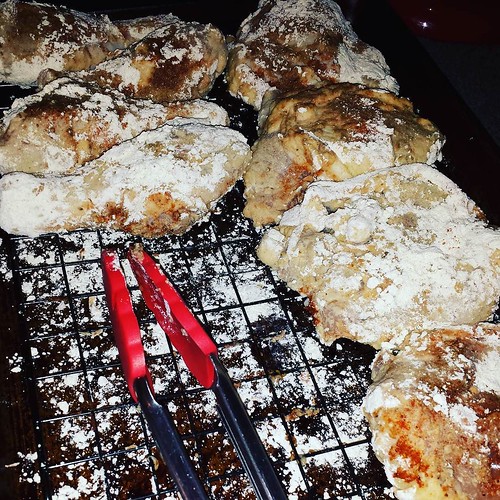
Alton Brown’s method in the Good Eats episode is actually for pan frying the chicken, not deep frying it. But the preparation steps are the same, as are the food-handling tips he provides, so I used all those: long buttermilk soak, liberal seasoning of both sides of the chicken, flour dredging, and resting the pieces. I did rest the pieces much longer than Brown calls for – in fact, the last pieces to go in ended up with a 40-minute rest period! But all was well, so I wasn’t worried. I also did not season the dredging flour itself, heeding Brown’s advice that some spices do burn so they’re better off being shielded beneath the flour than being mixed in with it.
And then, into the oil with the chicken!
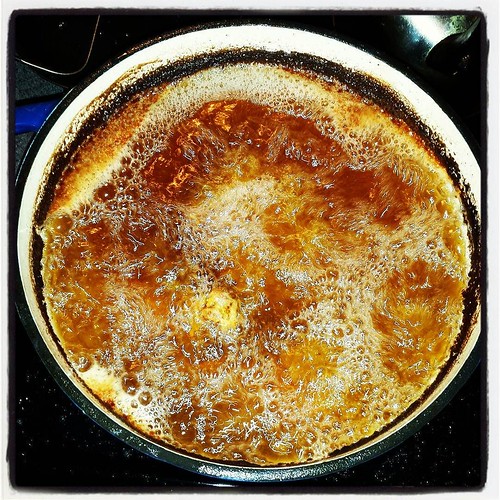
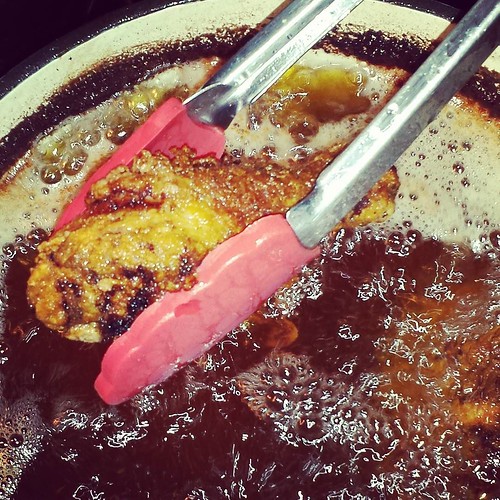
As noted, Brown is pan frying his chicken in the show, so he uses vegetable shortening that he heats to 350 degrees. I used vegetable oil to deep fry my chicken, and here I heeded a piece of advice from Lagasse: I used a lower temperature, only 300 degrees (which dipped into the 280-range when the pieces first went in). I had about three inches deep worth of oil in my Dutch oven, and I did four pieces at a time, ten minutes to a side each. Doing the math, it took me about an hour to fry up a dozen pieces of chicken – another reason I don’t do this all that often. Lagasse recommends the lower heat because he believes that higher heat can result in a scorched crust on the chicken by the time the meat is done. Again, I did not experiment to see if he was right. I did, however, follow his advice, and the result was highly satisfactory.
Finally, out came the chicken:
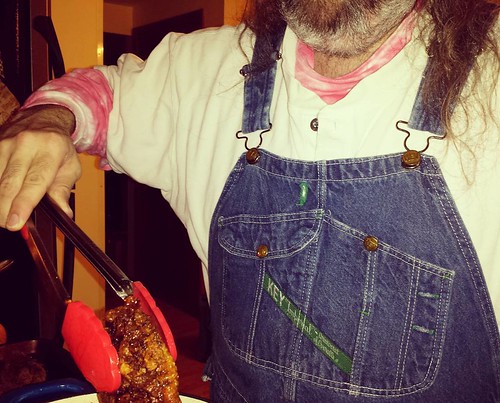
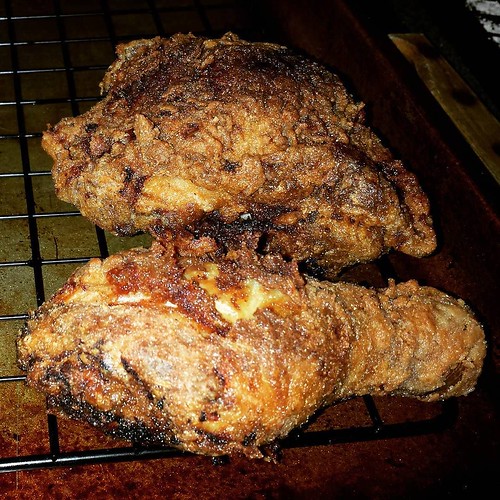
Those two pieces above are from the last batch, which was quite noticeably darker than the first batch, because of more bits of stuff floating around in the oil by the time I got to them. They were still awesome, though.
Oh, and that book excerpt I link above? I think she’s wrong when she says that the chicken must be fried at the last minute. If anything, the chicken should be fried first, and then allowed to rest for a while before eating. I had more than enough time to throw together a batch of cornbread and bake it in between the batches. It’s generally my belief that you do not want to eat fried chicken within at least fifteen minutes of removing it from the fryer. The stuff stays warm for a really long time, and cooked meat of any type should always be rested.
How did the chicken come out in the end? Well, the family ate it all up and promptly scolded me for not making enough. I made twelve pieces. That should tell you something. That was some good chicken, folks! And The Wife didn’t get sick from eating it! Yay! Yeah, we really set the culinary bar high here at Casa Jaquandor: food has to both taste good and not make The Wife sick.
A couple other random thoughts:
:: This gadget is awesome:
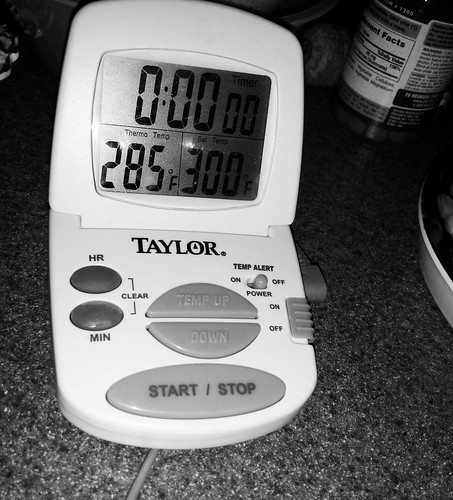
It’s a combo timer and probe thermometer. The probe is on a really long high-temp cord, so you can actually set the probe in a piece of food in the oven and set the gizmo to alert you when a target temperature is reached. Or you can use it as a straight-up timer. Very useful. I recommend it.
:: I also recommend that every kitchen on Earth have at least one of these:
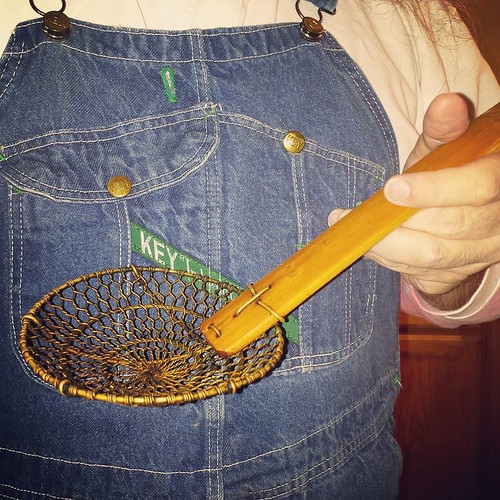
The spider skimmer is a Chinese invention that is ideal for removing food items from hot liquids. Seriously, you need one of these if you don’t have one. You might even need two.
:: This was the first time I ever used my Dutch oven for deep frying. Prior to this, I always used my wok, which works just fine. The wok is a perfectly acceptable pan for deep frying. I prefer the Dutch oven, though. Its straight sides give more room at the pan’s bottom for the chicken pieces to do their thing without touching each other and getting clingy. Also, the Dutch oven is narrower at the top, which means that I could use my splatter-shield gizmo to contain the splattering oil. With the taller pot and the lower oil temp, there wasn’t really much splatter at all, but being able to use the shield was a bonus. (I know, I can get a shield wide enough for the wok.)
:: Always take time while cooking to pet the cat.
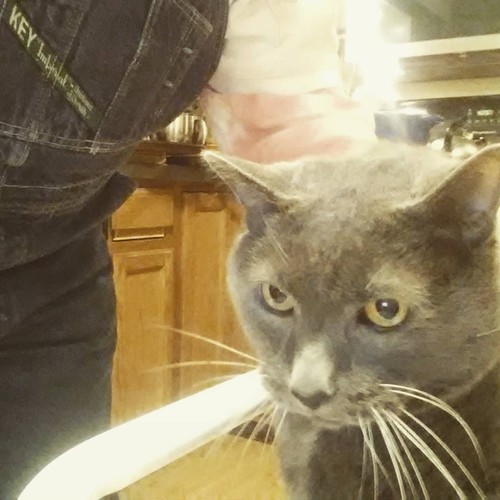
And I always wonder, why don’t more cooks and chefs wear overalls in the kitchen? Their whole purpose is to be protective! Comfort is supreme, they’re not super hot to wear, owing to their looser fit than regular pants, having pockets to stick utensils is nice, and I like to hang a towel off the hammer loop to wipe my hands on. Anyway....
So there you have it: making gluten-free fried chicken. Next time I’ll probably make two dozen pieces. And I’ll be frying for two hours....


No comments:
Post a Comment